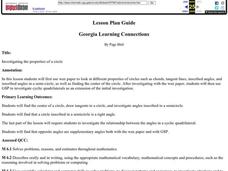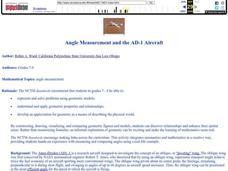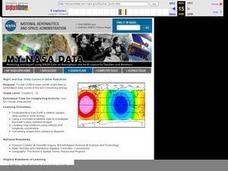Curated OER
ASL Lesson 2
Empower your non-verbal, autistic, or learning-impaired child with sign language. Lesson 2 in this functional and straight-forward series focuses on vocabulary related to familial relationships and ASL grammar. Video clips and images of...
EngageNY
Addition and Subtraction Formulas 1
Show budding mathematicans how to find the sine of pi over 12. The third lesson in a series of 16 introduces the addition and subtraction formulas for trigonometric functions. Class members derive the formulas using the distance formula...
Curated OER
Geometry in Tessellations
Students examine tessellations and their geometric properties. Students also develop a better understanding of lines, planes, angles, and polygons.
Curated OER
Quilt Patch Proof
Students construct a convincing argument that the same amount of fabric is needed for each color of quilt being made in a specific design. They justify the relationship between vertical angles and the sum of the interior angles. Students
Curated OER
Investigating the properties of a circle
Students use wax paper to look at different properties of circles such as chords, tangent lines, inscribed angles, and inscribed angles in a semi-circle, as well as finding the center of the circle, and use GSP to investigate cyclic...
Curated OER
BASEBALL HOME RUN
Students determine whether a hit baseball is a home run or not by utilizing parametric equations to describe the path of the ball. They assess the importance of angles and velocity needed to hit a home run. In addition, in their own...
Curated OER
NON-EUCLIDEAN GEOMETRY.
Students study relationships between angles, side lengths, perimeters, areas and volumes of similar objects. In this lesson students also create and critique inductive and deductive arguments concerning congruency, similarity and the...
Curated OER
Geometry Problem Set I
Students prove angles congruent by use of vertical angles definition, subtraction postulate, and transitivity postulate.
Curated OER
Pythagorean Theorem: Triangles and Their Sides
Young scholars investigate triangles and their relationship to each other. In this geometry lesson, students solve right triangles using the properties of the Pythagorean Theorem. They differentiate between right, acute, straight and...
Curated OER
Angle Measurement and the AD-1 Aircraft
Students represent and solve problems using geometric models and apply geometric properties and relationships. They also practice constructing and measuring angles. By constructing, drawing, visualizing, and comparing geometric figures...
Curated OER
Setting the Standard
Fourth graders experience and practice measuring and weighing objects. They describe relationships among units of measure for length, capacity, and weight, and determine measurements of angles utilizing appropriate tools. Groups are...
Curated OER
Soccer Problem
Students solve problems with triangles. For this geometry lesson, students use the properties of triangles to solve problems. They identify the median, altitude and side vs angle relationship.
EngageNY
Writing and Solving Linear Equations
Incorporate geometry into the solving linear equations activity. Pupils use their knowledge of geometry to write linear equations which reinforces geometry measurement concepts while at the same time providing a familiar context for...
Curated OER
NIGHT AND DAY: DAILY CYCLES IN SOLAR RADIATION
High schoolers examine how Earth's rotation causes daily cycles in solar energy using a microset of satellite data to investigate the Earth's daily radiation budget and locating map locations using latitude and longitude coordinates.
Mr. Williams Maths
Eight Circle Theorems Page
Your learners will find these circle theorems nicely organized with diagrams included that present the geometric relationships between the circle circumference, chords, central and circumference angles and tangents.
CK-12 Foundation
Airplane
How does an airplane control its take off and descent? Scholars explore the forces acting on an airplane and control the angle of attack, wing profile, thrust, and airplane size. They learn about lift, drag, thrust, gravity, and the...
Math Stars
Math Stars: a Problem-Solving Newsletter Grade 8
You've just hit the jackpot of integrating math problems and riddles with this jumbo-sized resource! Written as a newsletter, scroll through 35 pages of puzzles and quality problems to engage and encourage your learners to inquire and...
Curated OER
A Special Relationship
Young scholars discover the relationships of the lengths of the sides of right triangles and right triangles using a series of drawings on dot paper. They investigate and solve problems of standard (customary and metric units) and...
Curated OER
You Can't Go Wrong with a Right Triangle 2
Upper graders use the properties of right angle trignonmetry to measure objects such as the school flagpole. They solve real world problems using these properties.
Curated OER
Solving Problems Using Triangle Inequality Theorem
Sixth graders investigate triangles and the inequality theorem. They will collaborate in groups to determine the length of a longest side of a triangle. Then relate the size of the triangle to its angles using protractors, yard sticks,...
Curated OER
Property Lists for Quadrilaterals
Young scholars establish classifications of shapes by various properties (angles, sides, etc.). They introduce the important properties of common shapes. Students develop an awareness of the wide variety of ways the 2-D shapes can be alike.
Curated OER
Painting Modern Life
Examine three Cubism art pieces by Pablo Picasso and Georges Braque with your students. They will research how Cubism was advanced due to Picasso and Braque. and then compare and contrast Cubist works through image based discussion. Your...
Curated OER
Exploring Harmonic Conjugates
High schoolers investigate harmonic conjugates using Cabri Software or the Ti Calculator to analyze harmonics. They explore different angles measurements as they move their circles around and solve problems.
Curated OER
Goldsworthy Project: Building With the Five Elements of Art
Seventh graders explore the five elements of art: line, shape, value, texture and color. They collect items from nature and arrange them aesthetically taking the five elements into consideration. They consider their work from several...

























